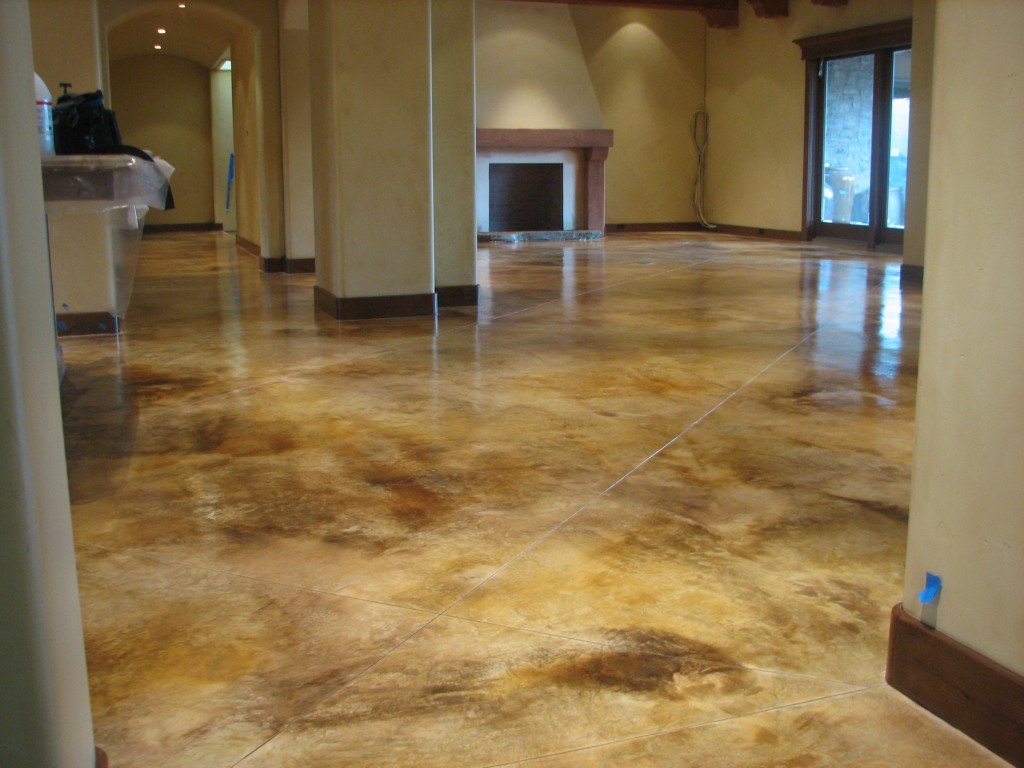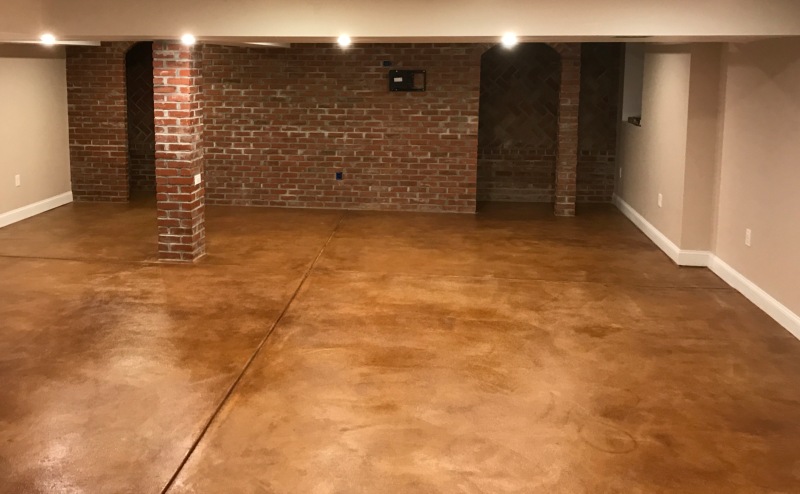The long-lasting strength of austin stained concrete floors explained
All About Stained Concrete: A Comprehensive Overview to Its Advantages and Applications
Stained concrete has actually become a preferred choice for both household and industrial areas. Its ability to incorporate aesthetic charm with functionality makes it an interesting option. Various staining methods supply a range of shades and coatings, permitting personalization. The advantages extend beyond appearance. Comprehending its applications and upkeep requirements is important for anybody considering this flexible product. The subtleties of stained concrete welcome additionally exploration.
What Is Stained Concrete?

Discoloration can be put on numerous surface areas, consisting of floorings, driveways, and outdoor patios, making it a flexible alternative for both interior and outside areas. The therapy can attain an array of looks, from natural tones to vibrant, modern-day designs. Unlike paint, stained concrete maintains its appearance in time, as it ends up being an integral part of the concrete itself. Overall, stained concrete serves as an effective method for changing average concrete into aesthetically striking surfaces.
Advantages of Stained Concrete
Stained concrete offers significant advantages, specifically in aesthetic charm and longevity - Stained Concrete Austin. Its vibrant colors and unique patterns improve the visual charm of any kind of area, making it a preferred selection for both residential and industrial applications. In addition, the long life of stained concrete warranties that it continues to be a functional financial investment gradually, standing up to deterioration
Aesthetic Charm
One of one of the most compelling benefits of utilizing stained concrete is its amazing aesthetic allure. Stained concrete offers a distinct and versatile appearance that can enhance numerous style styles, from modern-day to rustic. The infusion of vivid colors and detailed patterns permits house owners and developers to produce tailored surfaces that can boost the total atmosphere of an area. Unlike standard flooring options, stained concrete can mimic the look of all-natural stone or sleek marble, supplying an upscale look without the linked expenses. Furthermore, the shiny surface alternatives can reflect light, additional lightening up interiors. This versatility makes stained concrete a preferred option for both household and business applications, where aesthetic influence is critical.
Durability and Longevity
The impressive aesthetic qualities of stained concrete are matched by its amazing resilience and longevity - Stained Concrete Floors Austin. Stained concrete surfaces are immune to deterioration, making them appropriate for high-traffic areas both indoors and outdoors. Their durable nature implies they can withstand extreme weather problems, consisting of severe temperature levels, rainfall, and UV direct exposure, without substantial destruction. Furthermore, stained concrete requires very little upkeep compared to other flooring options, as it does not require constant securing or refinishing. This longevity not only minimizes substitute expenses however also adds to a lasting structure technique. In general, stained concrete supplies an enduring remedy that integrates visual charm with sensible benefits, guaranteeing its worth over time
Various Types of Staining Techniques
Various staining strategies can noticeably influence the aesthetic high qualities of concrete surface areas. The 3 main techniques consist of acid discoloration, which responds chemically with the concrete, water-based staining, which offers a broader range of shades, and overlay staining alternatives that offer a fresh surface. Each technique has distinct attributes and applications that satisfy numerous design choices and project requirements.
Acid Discoloration Approach
Just how can homeowners change plain concrete surfaces into visually striking functions? One efficient method is acid discoloration, a preferred technique that enhances the natural elegance of concrete. This procedure involves using a solution of water, hydrochloric acid, and metal salts to the concrete surface area. As the acid responds with the lime present in the concrete, it creates rich, variegated colors that look like marble or rock. Acid staining is understood for its toughness and resistance to fading, making it a lasting choice for both interior and outdoor applications. It is vital to note that the results can vary based on the initial concrete color and structure. Correct application and securing are important for attaining the wanted aesthetic and long life
Water-Based Staining Technique
A prominent choice to acid discoloration, the water-based discoloration strategy provides home owners a versatile way to improve concrete surface areas. This technique uses water-soluble dyes and pigments, enabling a variety of shades and finishes. Unlike acid stains, water-based spots can be used to unsealed concrete and use an easier cleaning process. The outcomes can attain a much more uniform appearance and can be layered to create one-of-a-kind effects. In addition, water-based discolorations are usually much less toxic and send out fewer volatile organic substances (VOCs), making them more eco-friendly. Property owners may appreciate the ability to customize their concrete surface areas with numerous tones, enabling innovative expression while keeping resilience and durability in their floor covering choices.
Overlay Discoloration Options
Various overlay staining choices exist for home owners wanting to renew their concrete surface areas. One prominent option is acid discoloration, which responds chemically with the concrete to create rich, variegated colors. An additional choice is water-based staining, offering a more comprehensive shade scheme and much easier application. Furthermore, concrete overlays can be incorporated with patterns for intricate designs, enhancing appearances. For a more distinctive finish, home owners might consider using stamped overlays that resemble natural products like stone or ceramic tile. Each strategy gives unique advantages, from sturdiness to modification, enabling an individualized touch. Ultimately, the selection of overlay discoloration depends upon the wanted look and the problem of the existing concrete, guaranteeing a revitalized and appealing surface area.
Applications of Stained Concrete
Stained concrete offers a versatile remedy for various applications, improving both aesthetic charm and performance. This material is typically made use of in property, business, and commercial settings, making it a prominent option amongst engineers and developers. In homes, stained concrete can serve as trendy flooring or outdoor patios, offering an innovative look while staying durable.
In industrial areas, such as stores and dining establishments, stained concrete adds to a contemporary ambiance and can stand up to hefty foot traffic. Additionally, stained concrete is progressively utilized in public areas like parks and walkways, where its ability to resemble all-natural stone or other materials includes aesthetic passion.
Furthermore, stained concrete is ideal for swimming pool decks and driveways, using a slip-resistant surface area that is very easy to keep. Overall, the versatility of stained concrete makes it suitable for numerous atmospheres, accommodating varied tastes and requirements.
Upkeep and Care for Stained Concrete
Appropriate maintenance guarantees the long life and beauty of stained concrete surface areas. Regular cleaning is necessary; using a mild detergent and water with a soft-bristle brush assists get rid of dirt and crud without damaging the coating. It is suggested to prevent rough chemicals that can remove away the tarnish or sealer.
Securing stained concrete is essential for defense against read moisture, discolorations, and use. A high-quality sealant ought to be reapplied each to 3 years, depending on the traffic and direct exposure the surface area sustains. Additionally, attending to spills without delay will prevent discoloration and discoloration.

Cost Considerations for Stained Concrete Projects
When planning a tarnished concrete task, budget factors to consider play an important duty in identifying the general cost. The costs associated with stained concrete can differ significantly based upon a number of factors. Initially, the size of the area to be stained straight influences product and labor costs. Larger rooms will naturally require even more resources. Second, the kind of discolor picked-- acid-based or water-based-- can impact prices, with acid spots typically being more costly. Furthermore, the complexity of the design, including patterns or numerous shades, can enhance labor expenses. Preparation work, such as cleaning and grinding the concrete surface, includes to the initial costs too. The option between Do it yourself installment and employing a professional specialist will certainly additionally impact the budget plan. Recognizing these variables makes it possible for homeowners to make informed financial decisions regarding their stained concrete jobs, ensuring they achieve the wanted aesthetic within their monetary ways.
Tips for Picking the Right Stained Concrete for Your Room
Choosing the best stained concrete for a certain area includes mindful consideration of different variables past simply budget. Initially, one should review the designated use the area. High-traffic zones might require more sturdy surfaces, while ornamental applications can focus on aesthetic appeals.
The color combination is another essential element; the selected colors need to balance with existing official source style and illumination. It's likewise important to take into consideration the surface appearance, as smooth coatings can boost elegance, while distinctive alternatives might guarantee security in wet locations.
Neighborhood environment and ecological conditions play a considerable function in the longevity and upkeep of stained concrete, influencing the option of sealers and surfaces.
Ultimately, speaking with specialists can offer useful understandings tailored to particular demands, assuring the choice of the excellent stained concrete that lines up with both capability and design.

Often Asked Concerns
Can Stained Concrete Be Applied Over Existing Flooring?
Stained concrete can undoubtedly be used over existing floor covering, provided the surface area is steady and sufficiently prepared. This method permits a visual upgrade without the need for full elimination of the original floor covering materials.
Just How Long Does Stained Concrete Last?
Stained concrete can last for decades when properly kept. Aspects such as website traffic, environmental problems, and application strategies substantially affect its longevity, with many installations continuing to be vivid and undamaged for 10 to 30 years.
Is Stained Concrete Slippery When Wet?
Stained concrete can be slippery when wet, as the finish might create a smooth surface area. Using non-slip additives or textured surfaces can reduce this problem, boosting safety without endangering the aesthetic allure of the concrete.
Can I Tarnish Concrete Myself, or Should I Employ a Professional?
The choice to tarnish concrete personally or work with a specialist hinges on skill degree and job complexity. While DIY staining can conserve money, specialists guarantee perfect results, particularly for complex layouts or huge surfaces.
What Color styles Are Readily Available for Stained Concrete?
The variety of colors available for he has a good point stained concrete includes natural tones like browns and tans, vivid tones such as reds and blues, and softer hues like pastels. This palette enables imaginative, customized layout choices.